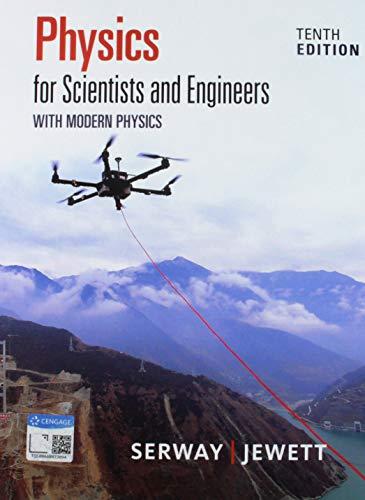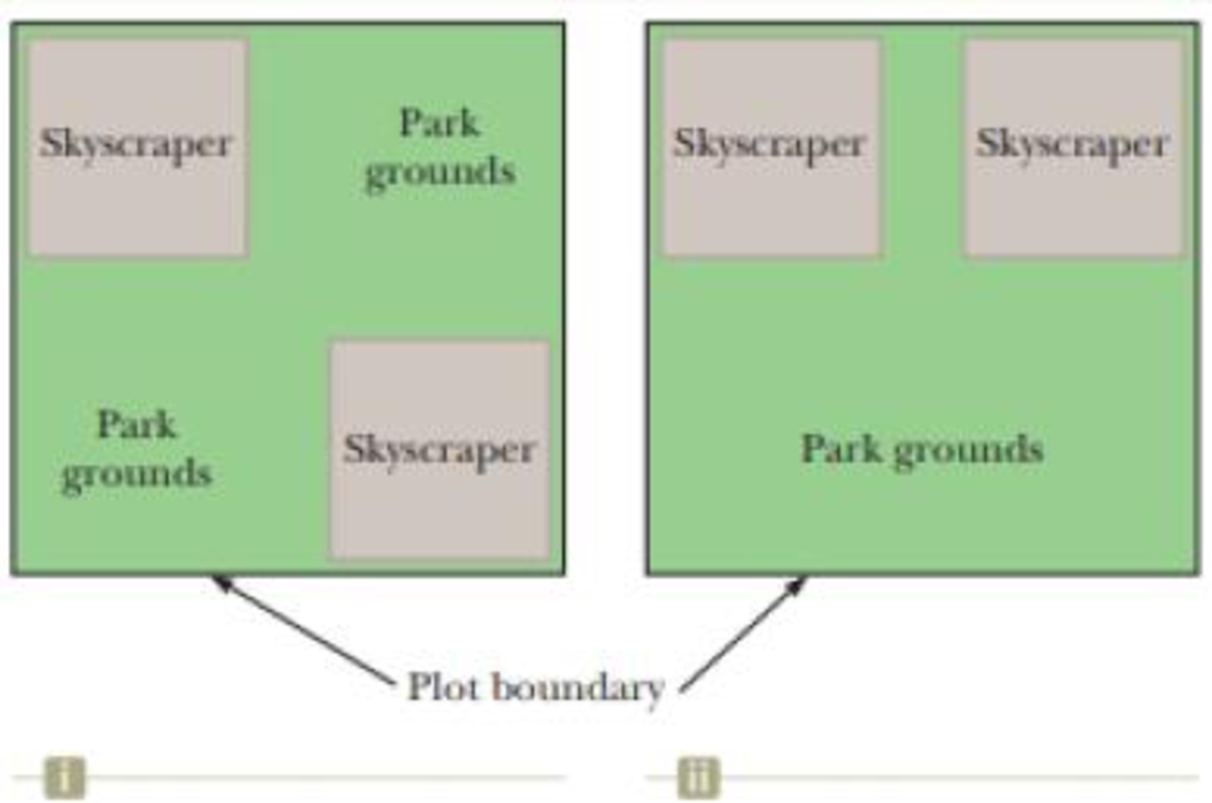
Concept explainers
You are working as an expert witness for the owner of a skyscraper complex in a downtown area. The owner is being sued by pedestrians on the streets below his buildings who were injured by falling glass when windows popped outward from the sides of the building. The Bernoulli effect can have important consequences for window’s in such buildings. For example, wind can blow around a skyscraper at remarkably high speed, creating low pressure on the outside surface of the windows. The higher atmospheric pressure in the still air inside the buildings can cause windows to pop out. (a) In your research into the case, you find some overhead views of your client’s project, as shown below. The project includes two tall skyscrapers and some park area on a square plot. Plan (i) (Fig. P14.26(i), page 382) was submitted by the original architects and planners. At the last minute, the owner decided he didn’t want the park grounds to be divided into two areas and submitted Plan (ii) (Fig. P14.26(ii), which is the way the project was built. Explain to your client why Plan (ii) is a much more dangerous situation in terms of windows popping out than Plan (i). (b) Your client is not convinced by your conceptual argument in part (a), so you provide a numerical argument. Suppose a horizontal wind blows with a speed of 11.2 m/s outside a large pane of plate glass with dimensions 4.00 m × 1.50 m. Assume the density of the air to be constant at 1.20 kg/ m3. The air inside the building is at atmospheric pressure. Calculate the total force exerted by air on the windowpane for your client. (c) What If? To further convince your client of the problems with the building design, calculate the total force exerted by air on the windowpane if the wind speed between the buildings is 22.4 m/s, twice as high as in part (b).
Figure P14.26

Want to see the full answer?
Check out a sample textbook solution
Chapter 14 Solutions
Bundle: Physics For Scientists And Engineers With Modern Physics, 10th + Webassign Printed Access Card For Serway/jewett's Physics For Scientists And Engineers, 10th, Multi-term
- Which of the following best describes how to calculate the average acceleration of any object? Average acceleration is always halfway between the initial acceleration of an object and its final acceleration. Average acceleration is always equal to the change in velocity of an object divided by the time interval. Average acceleration is always equal to the displacement of an object divided by the time interval. Average acceleration is always equal to the change in speed of an object divided by the time interval.arrow_forwardThe figure shows the velocity versus time graph for a car driving on a straight road. Which of the following best describes the acceleration of the car? v (m/s) t(s) The acceleration of the car is negative and decreasing. The acceleration of the car is constant. The acceleration of the car is positive and increasing. The acceleration of the car is positive and decreasing. The acceleration of the car is negative and increasing.arrow_forwardWhich figure could represent the velocity versus time graph of a motorcycle whose speed is increasing? v (m/s) v (m/s) t(s) t(s)arrow_forward
- Unlike speed, velocity is a the statement? Poisition. Direction. Vector. Scalar. quantity. Which one of the following completesarrow_forwardNo chatgpt pls will upvote Already got wrong chatgpt answerarrow_forward3.63 • Leaping the River II. A physics professor did daredevil stunts in his spare time. His last stunt was an attempt to jump across a river on a motorcycle (Fig. P3.63). The takeoff ramp was inclined at 53.0°, the river was 40.0 m wide, and the far bank was 15.0 m lower than the top of the ramp. The river itself was 100 m below the ramp. Ignore air resistance. (a) What should his speed have been at the top of the ramp to have just made it to the edge of the far bank? (b) If his speed was only half the value found in part (a), where did he land? Figure P3.63 53.0° 100 m 40.0 m→ 15.0 marrow_forward
 Principles of Physics: A Calculus-Based TextPhysicsISBN:9781133104261Author:Raymond A. Serway, John W. JewettPublisher:Cengage Learning
Principles of Physics: A Calculus-Based TextPhysicsISBN:9781133104261Author:Raymond A. Serway, John W. JewettPublisher:Cengage Learning Physics for Scientists and Engineers: Foundations...PhysicsISBN:9781133939146Author:Katz, Debora M.Publisher:Cengage Learning
Physics for Scientists and Engineers: Foundations...PhysicsISBN:9781133939146Author:Katz, Debora M.Publisher:Cengage Learning Physics for Scientists and EngineersPhysicsISBN:9781337553278Author:Raymond A. Serway, John W. JewettPublisher:Cengage Learning
Physics for Scientists and EngineersPhysicsISBN:9781337553278Author:Raymond A. Serway, John W. JewettPublisher:Cengage Learning Physics for Scientists and Engineers with Modern ...PhysicsISBN:9781337553292Author:Raymond A. Serway, John W. JewettPublisher:Cengage Learning
Physics for Scientists and Engineers with Modern ...PhysicsISBN:9781337553292Author:Raymond A. Serway, John W. JewettPublisher:Cengage Learning College PhysicsPhysicsISBN:9781938168000Author:Paul Peter Urone, Roger HinrichsPublisher:OpenStax College
College PhysicsPhysicsISBN:9781938168000Author:Paul Peter Urone, Roger HinrichsPublisher:OpenStax College College PhysicsPhysicsISBN:9781305952300Author:Raymond A. Serway, Chris VuillePublisher:Cengage Learning
College PhysicsPhysicsISBN:9781305952300Author:Raymond A. Serway, Chris VuillePublisher:Cengage Learning





